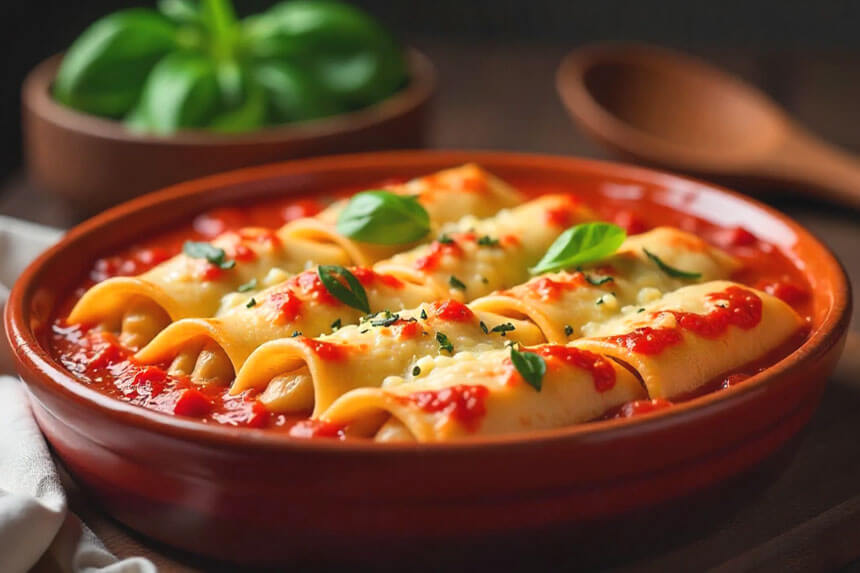Mannacote is the beloved Italian-American pasta dish that’s exactly the same as manicotti but with a twist in pronunciation. These large pasta tubes get stuffed with creamy ricotta cheese, covered in marinara sauce, and baked until the mozzarella cheese bubbles golden brown. You’ll find this hearty comfort food gracing dinner tables across America, especially in families who passed down the recipe through generations.
What Is Mannacote
Mannacote is simply another name for manicotti, the classic baked pasta dish that means “little sleeves” in Italian. Many Italian-American families use this dialectal pronunciation, and it stuck around in kitchens nationwide.
The term mannacote appears across recipe blogs and family videos because it carries the same warmth as the dish itself. Immigrant families often passed down recipes orally, and in doing so, the word manicotti morphed through thick accents or simplified speech. This mispronunciation became a badge of honor in many households, tied closely to family history and kitchen memories. Whether your family calls it mannacote or manicotti, you’re talking about the same delicious tube pasta filled with cheese and baked to perfection. The dish represents more than just dinner. This family-specific term connects families to their Italian roots while adapting to American tastes and ingredients. The term Mannacote may not be listed in traditional Italian cookbooks, but it’s definitely found in American kitchens.
How Mannacote Differs from Regular Manicotti
Mannacote and manicotti are technically the same dish, but the regional pronunciation tells a story. The term mannacote shows how food traditions travel and change through families and communities.
Both terms describe the same beloved baked pasta recipe: large pasta tubes stuffed with cheese or meat filling, covered in tomato sauce, and baked with bubbling cheese. The difference lies in the cultural journey rather than the recipe itself. Some families prefer the mannacote pronunciation because it feels more personal and connected to their specific heritage. Others stick with manicotti because it’s the standard term found in cookbooks and restaurants. This polysemy means the word can refer to both the actual dish and the pronunciation variation that carries emotional weight. No matter which name you use, you’ll end up with the same satisfying comfort dish that combines creamy filling, tangy sauce, and melted cheese in perfect harmony.
Essential Ingredients for Perfect Mannacote
You need ricotta cheese, mozzarella, Parmesan, eggs, fresh herbs, marinara sauce, and large pasta tubes to make authentic mannacote. These simple ingredients create layers of flavor that make this dish so special.
For home cooks, mannacote generally means stuffed tubes or thin crepes baked in a moderate oven until the center hits a safe, creamy set. The ricotta provides the creamy base, while mozzarella adds that stretchy, gooey texture everyone loves. Parmesan brings sharp, nutty notes that balance the mild ricotta perfectly. Fresh parsley or basil adds brightness to cut through the rich cheese. Two small moves make a big difference: drain ricotta briefly so the filling isn’t watery, and par-cook pasta just shy of al dente so it finishes tender in the oven without collapsing. Some cooks add an egg to bind the filling and prevent it from becoming too loose during baking. Ground beef or Italian sausage can transform this into a heartier meal for meat lovers. Ground beef plus ricotta creates a hearty, lasagna-style stuffing, while Italian sausage plus spinach adds savory notes with a hint of spice.
Step-by-Step Mannacote Recipe
Cook the pasta tubes until just shy of done, mix your cheese filling, stuff the tubes, layer with sauce, and bake until bubbly. This simple process creates restaurant-quality results at home.
Start by boiling salted water and cooking your manicotti shells for about 6-7 minutes until they’re still firm. Rinse with cold water and set on a baking sheet lined with parchment to prevent sticking. While they cool, mix ricotta, mozzarella, Parmesan, eggs, and herbs in a large bowl until smooth and creamy. Spoon the mixture into a zip-top bag or piping bag. Snip off the corner and pipe the filling into both ends of each tube. Don’t overstuff because the cheese expands during baking. Spread a generous layer of marinara or tomato sauce in the bottom of a greased baking dish. Arrange the stuffed tubes in a single layer, cover with remaining sauce, and top with mozzarella. Cover with foil and bake at 375°F for 30 minutes, then uncover and bake 10-15 minutes more until golden and bubbling. This homemade mannacote technique delivers the same results as cannelloni but uses easier-to-find pasta tubes.
Common Mistakes and How to Fix Them
Overcooking pasta, watery filling, and dry results are the biggest mannacote problems home cooks face. These issues are easy to prevent with the right techniques.
Many people cook the pasta tubes too long, which makes them fall apart during stuffing. Cook them just until you can handle them safely but they still have some firmness. Drain ricotta briefly so the filling isn’t watery, and avoid adding too much liquid to your cheese mixture. If your mannacote turns out dry, you probably didn’t use enough sauce or your oven temperature was too high. Cover the dish tightly with foil for most of the baking time to keep moisture in. Another common mistake is overstuffing the tubes, which causes them to burst and creates a messy presentation. Fill them generously but leave room for the cheese to expand as it heats. Unlike cold dishes or fresh pasta, this baked creation needs patience and proper moisture control.
Healthy Variations and Modern Twists
Replace regular pasta with gluten-free tubes, use part-skim ricotta, add vegetables, or try plant-based cheese for lighter versions. These swaps keep all the comfort while meeting modern dietary needs.
A serving of two stuffed tubes with sauce can have 400–500 calories, 20–25 grams protein, 20–30 grams fat, and 600–900 milligrams sodium. Healthier adjustments include using part-skim cheese, adding vegetables, and serving with salad. Add one cup of sautéed spinach to the cheese mixture for a nutritious boost, so consider mixing spinach, mushrooms, or zucchini into your filling for extra nutrients and flavor. Vegetarian mannacote swaps meat for spinach, mushrooms, or artichokes to preserve the comfort while lightening the mood. For dairy-free versions, cashew ricotta or vegan mozzarella work surprisingly well in this recipe. You can enjoy mannacote as part of a balanced lifestyle because it’s all about how you build your plate. Serve smaller portions alongside a large green salad to create a more balanced meal. Some families make mini versions using jumbo shells instead of tubes, which helps with portion control and makes the dish more kid-friendly.
Serving and Storage Tips
Serve mannacote hot from the oven with crusty bread and a simple salad for the perfect meal. Leftover portions reheat beautifully and often taste even better the next day.
Let the dish rest for 10-15 minutes after baking so the cheese sets up and makes serving easier. Sweet endings like panna cotta or tiramisu are classic Italian desserts that echo the meal’s comfort if you want to complete the Italian-American meal experience. It’ll keep in the fridge for a day, which makes it perfect for prepping before company arrives and an excellent choice for entertaining. Keep leftover mannacote fresh by storing it in an airtight container in the refrigerator for up to 4 days or freeze portions for up to three months. When reheating, cover with foil and warm gently in a 350°F oven until heated through. The flavors actually improve after a day in the refrigerator because the marinara sauce has time to soak into the pasta slightly. This casserole-style dish maintains its quality well during storage, unlike many other pasta preparations.
Why Mannacote Matters in Italian-American Culture
This dish represents family tradition, cultural heritage, and the blending of Italian and American food customs. Every family recipe tells a story about immigration, adaptation, and love expressed through cooking.
Mannacote in Italian-American homes represents a connection to ancestral roots, the preservation of old-world recipes, the blending of Italian and American culinary traditions, and a centerpiece for gatherings and celebrations. What’s special about mannacote isn’t just the taste, but what it represents: the bonding of cultures at the family table, the trust in time-honored techniques, and a willingness to adapt. Many families serve mannacote during holidays, Sunday dinners, and special occasions because it feeds a crowd and brings everyone together. This dish helps families remember where they came from and pass down that heritage with every bite. The pronunciation “mannacote” itself becomes part of family identity, separating the home version from restaurant manicotti and creating something uniquely theirs. Homemade or passed down through generations, each tray baked is a story told. This etymology from the Italian “manicotti” meaning “little sleeves” shows how language evolves alongside recipes in immigrant communities.
Mannacote proves that the best comfort foods aren’t just about taste. They’re about connection, tradition, and the way families pass down love through recipes. Whether you call it mannacote or manicotti, this baked pasta dish will always represent the heart of Italian cuisine adapted for American tables and the warmth of gathering around the dinner table with those you love most.














